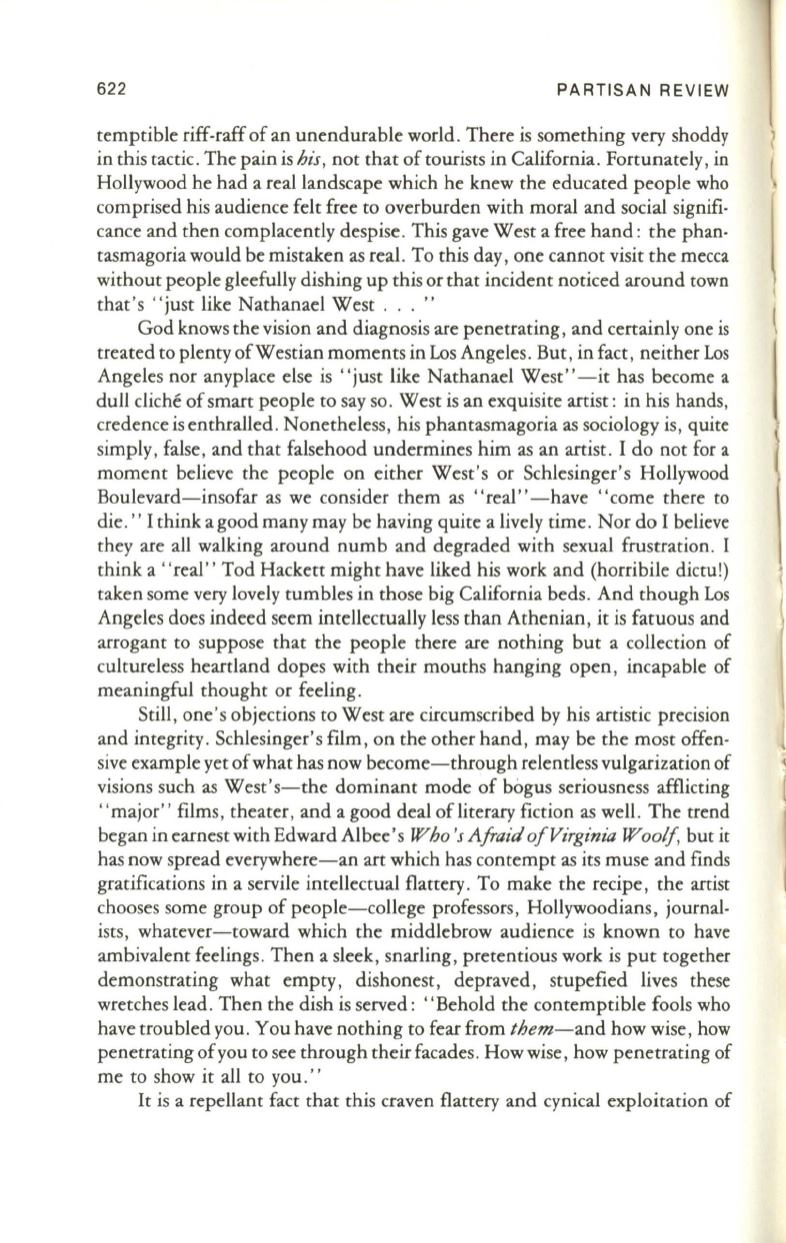
622
PARTISAN REVIEW
temptible riff-raff of an unendurable world. There is something very shoddy
in this tactic . The pain is
his,
not that of tourists in California. Fortunately, in
Hollywood he had a real landscape which he knew the educated people who
comprised his audience felt free to overburden with moral and social signifi–
cance and then complacently despise. This gave West a free hand: the phan–
tasmagoria would be mistaken as real. To this day, one cannot visit the mecca
without people gleefully dishing up this or that incident noticed around town
that's "just like Nathanael West ... "
God knows the vision and diagnosis are penetrating, and certainly one is
treated to plenty ofWestian moments in Los Angeles. But, in fact, neither Los
Angeles nor anyplace else is "just like Nathanael West"-it has become a
dull cliche of smart people to say so . West is an exquisite artist: in his hands,
credence is enthralled. Nonetheless, his phantasmagoria as sociology is, quite
simply, false, and that falsehood undermines him as an artist. I do not for a
moment believe the people on either West's or Schlesinger's Hollywood
Boulevard-insofar as we consider them as "real" -have "come there to
die ." I think a good many may be having quite a lively time. Nor do I believe
they are all walking around numb and degraded with sexual ftustration. I
think a "real" Tod Hackett might have liked his work and (horribile dictu!)
taken some very lovely tumbles in those big California beds. And though Los
Angeles does indeed seem intellectually less than Athenian, it is fatuous and
arrogant to suppose that the people there are nothing but a collection of
cultureless heartland dopes with their mouths hanging open, incapable of
meaningful thought or feeling .
Still, one's objections to West are circumscribed by his artistic precision
and integrity. Schlesinger's film, on the other hand, may be the most offen–
sive example yet ofwhat has now become-through relentless vulgarization of
visions such as West's-the dominant mode of bogus seriousness afflicting
,'major" films, theater, and a good deal of literary fiction as well. The trend
began in earnest with Edward Albee's
Who's Afraida/Virginia Woolf,
but it
has now spread everywhere-an art which has contempt as its muse and finds
gratifications in a servile intellectual flattery . To make the recipe, the artist
chooses some group of people-college professors, Hollywoodians, journal–
ists, whatever-toward which the middlebrow audience is known
to
have
ambivalent feelings . Then a sleek, snarling, pretentious work is put together
demonstrating what empty, dishonest, depraved, stupefied lives these
wretches lead . Then the dish is served: "Behold the contemptible fools who
have troubled you . You have nothing to fear from
them-and
how wise, how
penetrating of you to see through their facades. How wise, how penetrating of
me to show it all to you."
It
is a repellant fact that this craven flattery and cynical exploitation of


